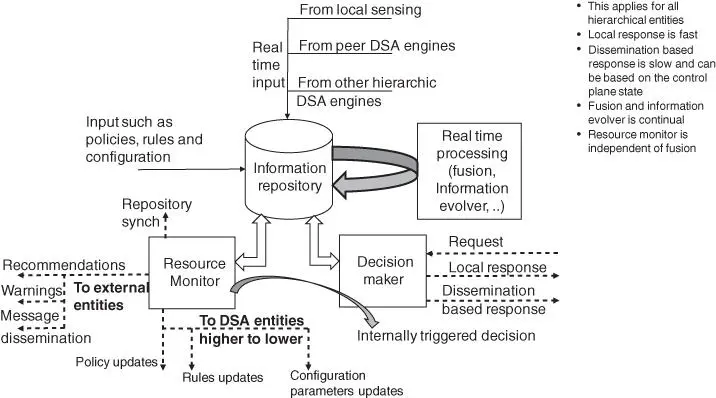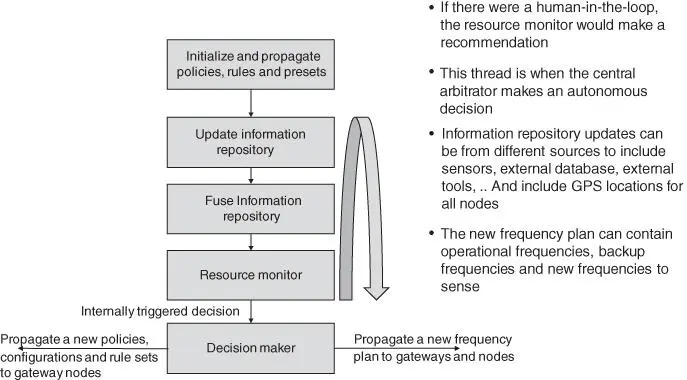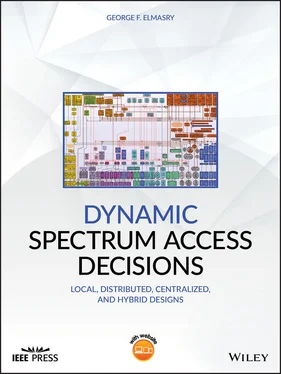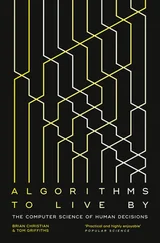Other considerations of this generic model include:
1 Reducing or eliminating the need for a human in the loop.
2 Creating harmony between the heterogeneous networks through consistent updates of policies and configuration parameters.
3 Utilizing the processing power of the upper hierarchy to process and disseminate global policies, rule sets, and configuration parameters.
4 In addition to reducing DSA control traffic volume going downward carrying policies, rules sets, and configuration parameters, this model reduces DSA control traffic going upward carrying spectrum sensing information where nodes and gateways fuse (and abstract) spectrum sensing information messages before forwarding them to upper networks entities.
5 Most importantly, make the best DSA decision available at any level of this hierarchy regardless of the control plane connectivity status.
5.2 The Generic DSA Cognitive Engine Skeleton
This section presents a generic construct of a DSA cognitive engine that can be followed at any of the hierarchical levels explained in the previous section. Although this book is not focused on cognitive engine design, it is appropriate to demonstrate that a common (skeleton) DSA cognitive engine concept can be followed at all entities of the hierarchy presented in this chapter in order to facilitate DSA as a set of cloud services. A DSA cognitive engine is responsible for many tasks, including spectrum sensing information fusion, offering DSA services and the propagation of policies, rule sets, and configuration parameters to the lower hierarchy entities.
Figure 5.2shows this generic representation of the DSA cognitive engine. At the center of this DSA cognitive engine is an information repository. This information repository can differ from one entity to another based on its hierarchy and place in the hierarchical networks. The information repository can receive real‐time input from local sensors, from peer DSA engines or from other hierarchic DSA engines. The information repository can also be affected by automation inputs such as policies, rules, and configurations. The information repository is coupled with an information fusion and evolver. The DSA engine also has a resource monitor that can create recommendations and warnings to external entities and can disseminate messages to other entities as needed. The resource monitor can trigger policy updates, rules updates or configuration parameter updates that propagate from higher DSA entities to lower DSA entities. The DSA decision maker is a separate process that receives DSA services requests and responds to these requests. A request can be a local request or a dissemination request as explained above. The resource monitor can create internally triggered decisions (as a result of spectrum sensing information fusion) and pass them to the decision maker for consideration.

Figure 5.2The generic cognitive engine representation that can be used at any network hierarchical entity offering DSA services.
As Chapter 8 explains, the decision maker can consider the impact of co‐site interference before disseminating a response to a service request.
Notice that:
this skeleton architecture applies for all hierarchical DSA decision making entities.
local response should be instantaneous.
dissemination based response should be slower and can depend on the control plane state.
fusion and information evolver is a continual process that can update the information repository. The information repository can be updated based on external messages or based on local analysis. An example of this internal update is the ROC model hypothesizing threshold explained in Chapter 3. For example, local analysis at a gateway can update this threshold value and create a message that disseminates to the network nodes to update the value of this threshold in order to adjust the tradeoff between the probability of false alarm and the probability of misdetection.
This book is not about developing cognitive engines. However, some critical threads of this cognitive engine skeleton are worth covering to show some key aspects of the decision‐making process.
5.2.1 The Main Thread in the Central Arbitrator DSA Cognitive Engine
This section shows how the generic cognitive engine construct used in the central arbitrator can execute the thread illustrated in Figure 5.3. The importance of this thread is that it is the initialization thread and subsequent threads can be considered a subset of this thread, as indicated by the curved arrow at the right‐hand side of the figure. The curved arrow means that the update to the information repository, the fusion of information, and the monitor of resources will continue to occur as a loop. At any moment, this loop can trigger a decision to propagate a new policy, rule set or configuration parameters or propagate a new frequency assignments. Note that there is no need for a human in the loop. The central arbitrator decisions are autonomous. Configuration parameters can be updated and propagated autonomously.

Figure 5.3The main thread in the central arbitrator.
Notice with Figure 5.3that information repository updates can be:
from external sources to include sensors, external database, and external tools.
geolocation information updates propagated from lower hierarchy.
a result of fusion that evolves the states of the DSA cognitive engine.
The decision maker can create a new frequency plan that includes:
new frequency assignments to some or all networks (change of operational frequencies).
new backup frequencies for each network (Note that backup frequencies, much like operational frequencies have to be a result of decision fusion so that they are spatially separated and when nodes use them for connectivity, nodes will not suffer from interference due to lack of spatial separation or from external systems in the same geographical location.).
sensing frequency. (Note that in order to reduce the control traffic volume, the central arbitrator may select a subset of sensing capable nodes per each network. Not all sensors must be activated at all the times. This subset of sensors can be geographically dispersed to create a comprehensive spectrum map for the least amount of spectrum sensing control traffic volume.)
5.2.2 A Critical Thread in the Gateway DSA Cognitive Engine
One critical trigger that can reach the DSA cognitive engine in the gateway node is the receipt of a frequency plan from the central arbitrator. As mentioned earlier, the gateway DSA engine can defer frequency change in its network to the central arbitrator or the central arbitrator's own fusion can trigger a frequency change (frequency plan) that affects one or more networks. This frequency plan can contain frequency change for a network that the gateway is a node of, a list of frequencies to sense within the network identifying which sensor would sense which frequency, and a list of backup frequencies for the network to consider when network formation using the operational frequency fails. This is one of many possible paths that can go through the gateway DSA cognitive engine.
As Figure 5.4shows, once the frequency plan is received by the gateway cognitive engine, it will result in an update to the gateway information repository and this update should trigger the decision maker to perform the following steps:
Читать дальше














